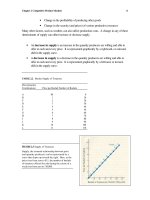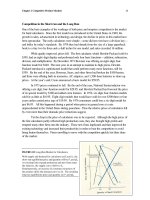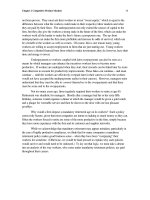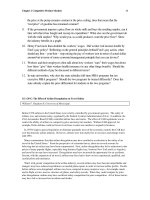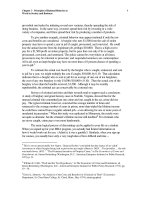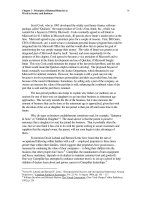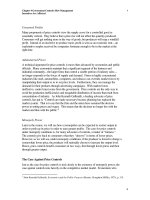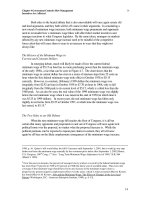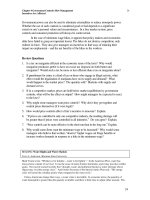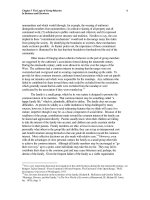Tài liệu Microeconomics for MBAs 56 pdf
Bạn đang xem bản rút gọn của tài liệu. Xem và tải ngay bản đầy đủ của tài liệu tại đây (158.15 KB, 10 trang )
Chapter 16 Public Choice: Politics in
Government and the Workplace
9
including both city and suburbs, could spread the tax burden over all those who benefit
from city services.
Consolidation can be a mixed blessing, however, if it reduces competition among
governments. A large government restricts the number and variety of alternatives open to
citizens and increases the cost of moving to another locale by increasing the geographical
size of its jurisdiction. Consolidation, in other words, can increase government’s
monopoly power. As long as politicians and government employees pursue only the
public interest, no harm may be done. In fact, the people who run government have
interests of their own. So the potential for achieving greater efficiency through
consolidation could easily be lost in bureaucratic red tape. Studies of consolidation in
government are inconclusive, but it seems clear that consolidation proposals should be
examined carefully.
The Economics of Government Bureaucracy
Bureaucracy is not limited to government. Large corporations like General Motors and
AT&T employ more people than the governments of some nations. They are bigger than
the major departments of the federal government—although no company, of course, is as
large as the federal government as a whole. Yet corporate bureaucracy tends to work
more efficiently than government bureaucracy. The reason may be found in the fact that
it pursues one simple objective—profit—that can be easily measured in dollars and cents.
Certainly the reason cannot be that stockholders are better informed than voters.
Most stockholders are rationally ignorant or their companies’ doings, for the cost of
becoming informed outweighs the benefits. Even in very large corporations, however,
some individuals hold enough stock to make the acquisition of information a rational act.
Often such stockholders sit on the company’s board of directors, where their interest in
increasing the value of their own shares makes them good representatives of the rest of
the stockholders. The crucial point is that this informed stockholder has one relatively
simple objective—profit—and can find out relatively easily whether the corporation is
meeting it. The voter, on the other hand has a complicated set of objectives and must do
considerable digging to find out whether they are being met.
Because most corporations function in competitive markets, the stockholder’s
drive toward profit is reinforced. General Motors knows that its customers may switch to
Toyota if it offers them a better deal. In fact, stockholders can sell their General Motors
stock and buy stock in Toyota. Thus corporate executives make decisions on the basis of
the consumer’s well being—not because they wish to serve the public good but because
they want to make money.
Government bureaucracies, on the other hand, tend to produce public goods and
services for which there is no competition. No built-in efficiencies guard the taxpayer’s
interests in a government bureaucracy. Both government bureaucrats and corporate
executives base their decisions on their own interests, not those of society, but
competition ensures that the interests of corporate decision makers coincide with those of
consumers. No such safeguards govern the operations of government bureaucracies.
Bureaucracies are constrained by political, as opposed to market, forces.
Chapter 16 Public Choice: Politics in
Government and the Workplace
10
From the economist’s point of view, one of the advantages of the profit-
maximizing goal of competitive business is that it enables predictions. Although some
business people pursue other goals—personal income, power, respect in the business—
their behavior can generally be well explained in terms of the single objective, profit.
There is no single goal like profit that drives the government bureaucracy. Different
bureaucracies pursue different objectives. We do not have time or space to consider all
the possible objectives of bureaucracy, but we will touch on three: monopolistic profit
maximization, size maximization, and waste maximization.
Profit Maximization
Assume that police protection can be produced at a constant marginal cost, as shown by
the horizontal marginal cost curve in Figure 16.2. The demand for police protection is
shown by the downward-sloping demand curve D. If individuals could purchase police
service competitively at a constant price of P
1
, the optimum amount of police service
would be Q
2
, the amount at which the marginal cost of the last unit of police service
equals its marginal benefit. The total cost would be P
1
x Q
2
(or the area 0P
1
a Q
2
),
leaving a consumer surplus equal to the triangular area P
1
P
3
a.
Police protection is usually delivered by regional monopolies, however. That is,
all police services in an area are supplied by one organization. These regional
monopolies have their own goals and their own decision-making process, which do not
necessarily match the individual taxpayers’. If police service must be purchased from
such a profit-maximizing monopoly, service will be produced to the point where the
marginal cost of the last unit produced equals its marginal revenue: Q
1
. The monopolist
will set that quantity above cost at price P
2
, making a profit equal to the rectangular area
P
1
P
2
ed.
_________________________________________
FIGURE 16.2 Bureaucratic Profit Maximization
Given the demand for police service, D, and the
marginal cost of providing it, MC, the optimum
quantity of police service is Q
2
. A monopolistic
police department interested maximizing its profits
will supply only Q
1
service at a price of P
2
,
however. (A monopolistic bureaucracy interested
in maximizing its size would expand police service
to Q
3
.)
Chapter 16 Public Choice: Politics in
Government and the Workplace
11
At the monopolized production level, there is still some surplus—the triangular
area P
2
P
3
e—left for consumers, but they are worse off than under competitive market
conditions. They get less police protection (Q
1
instead of Q
2
) for a higher price (P
2
instead of P
1
).
This analysis presumes that the police are capable of concealing their costs. If
taxpayers know that P
2
is an unnecessarily high price, the outcome will be the same as
under competition. They will force the police to produce Q
2
protection for a price of P
1
.
Size Maximization
In fact, a government bureaucracy is unlikely to take profit as its overriding objective, if
only because bureaucrats do not get to pocket the profit. Instead, government
monopolies may try to maximize the size of their operations. For if a bureaucracy
expands, those who work for it will have more chance of promotion. Their power,
influence, and public standing will improve, along with their offices and equipment.
What level of protection will a police department produce under such conditions?
Instead of providing Q
1
service and misrepresenting its cost at P
2
, it will probably
provide Q
3
service—more than taxpayers desire—at the true price of P
1
. The bill will be
P
1
x Q
3
, or the area 0P
1
b Q
3
in Figure 16.3. Note that the net waste to taxpayers, shown
by the shaded area abc, exactly equals the consumer surplus, P
1
P
3
a. By extending
service to Q
3
, the police have squeezed out the entire consumer surplus and spent it on
themselves.
_________________________________________
FIGURE 16.3 Bureaucratic Waste Maximization
Given a demand for police service D and a
marginal cost of providing it MC
1
, the optimum
quantity of police service will be Q
2
. A
monopolistic bureaucracy, however, may seek to
maximize waste by inflating its costs to MC
2
. It
will supply Q
2
units of police protection at a tax
price of P
2
instead of P
1
. The shaded area abc
shows the waste created, which exactly equals the
consumer surplus P
2
P
3
a.
Waste Maximization
Instead of maximizing the amount of service they offer, bureaucrats may choose to
maximize waste. They can increase their salaries, improve their working conditions, or
Chapter 16 Public Choice: Politics in
Government and the Workplace
12
reduce their workloads. All such changes increase the cost of providing a given amount
of service.
Figure 16.3 shows how far a bureau can go in increasing the cost of, or budget
for, its services. The marginal cost curve MC
1
is the minimum cost of providing
additional police protection. The optimum quantity of police protection is therefore Q
2
,
the same as in Figure 16.2, but if the police pad their costs, the marginal cost curve will
shift up to MC
2
. The bureau’s budget climbs from P
1
x Q
2
to P
2
x Q
2
. Note that beyond
Q
1
, the marginal cost of additional police service is now greater than its marginal benefit,
indicated by the demand curve. Again, the police are wasting taxpayers’ money, as
shown by the shaded triangular area abc. By moving their cost curve to MC
2
, they have
managed to extract all the consumer surplus (shown by the triangular area P
2
P
3
a) and to
spend it on unnecessary frills.
In real life, most bureaucratic monopolies may pursue both size maximization and
waste maximization. For each unit of service they provide, they will try to expand both
the size of their operation and the funds spent on it—but they do have to make tradeoffs
between the two objectives. Whenever they expand their size, they must forgo a certain
amount of expansion in their cost per unit of service. There is, after all, only so much
consumer surplus that can be extracted from the system.
Figure 16.4 shows one possible combination of size and budget maximization. In
this case the department chooses to expand its service from Q
1
to Q
2
. Having done so, it
can expand its cost per unit only to MC
2
. Again, the shaded triangular area that indicates
waste, abc, just equals the consumer surplus P
2
P
3
a.
Fortunately government bureaucracies do not usually achieve perfect
maximization of size or waste. For one thing, most legislatures have at least some
information about the production costs of various services, and bureaucrats may not be
willing to do the hard work necessary to exploit their position fully. If bureaucracy does
not manage to capture the entire consumer surplus, citizens will realize some net benefit
from their investment.
___________________________________
FIGURE 16.4 Size and Waste Maximization
Combined
The monopolistic bureaucracy may choose to
increase both its size and the cost of its service.
Any increase to one must come at the cost of the
other, however, for together the two increases must
not exceed the consumer surplus. Here net waste,
shown by the shaded triangular area abc, is divided
between size and cost increases. The area between
the two marginal cost curves MC
1
and MC
2
represents waste maximization. The are below the
marginal cost curve MC
1
represents size
maximization. The whole area abc exactly equals
the consumer surplus P
2
P
3
a.
Chapter 16 Public Choice: The Economics of Government
Making Bureaucracy More Competitive
What can be done to make government bureaucracy more efficient? Perhaps the
development of managerial expertise at the congressional level would encourage more
accurate measurement of the costs and benefits of government programs. Cost-benefit
analysis alone, however, will not necessarily help. As long as special-interest groups,
including those of government employees, exist, the potential for waste can be
substantial.
A better solution to bureaucratic inefficiency may be to increase competition in
the public sector. In the private marketplace, buyers do not attempt to discover the
production costs of the companies they buy from. They simply compare the various
products offered, in terms of price and quality, and choose the best value for their money.
A monopoly of any kind, of course, makes that task difficult if not impossible, but the
existence of even one competitor for a government bureaucracy’s services would allow
some comparison of costs. The more different sources of a service, the flatter the
demand curve faced by each source, and the more efficient it must be to stay in business.
How exactly can competition be introduced into bureaucracy? First, proposals to
consolidate departments should be carefully scrutinized. What appears to be wasteful
duplication may actually be a source of competition in the provision of service. In the
private sector, we would not expect the consolidation of General Motors, Ford and
Chrysler to improve the efficiency of the auto industry. If anything, we would favor the
breakup of the large firms into separate, competing companies. Why then should we
merge the sanitation departments of three separate cities?
A second way to increase the competitiveness of government services is to
contract for them with private producers. Many government activities that must be
publicly financed need not necessarily be publicly produced. In the United States,
highways are usually built by private companies but repaired and maintained by
government. Competitive provision of maintenance as well as construction might reduce
costs. Other services that might be “privatized” are fire protection, garbage collection,
and education.
Finally, competition can be increased simply by dividing a bureaucracy into
several smaller departments with separate budgets, thus increasing competition. Such a
change would reduce the costs citizens must bear to move to an area that offers better or
cheaper government services. The loss (or threat of loss) of constituents can put pressure
on government to improve its performance.
MANAGER’S CORNER: Why Professors Have
Tenure and Business People Don’t
Tenure is nothing short of a Holy Grail for newly employed assistant professors in the
country’s colleges and universities. Without tenure, faculty members must, as a general
rule, be dismissed after seven years of service, which means they must seek other
academic employment or retreat from academic life. With tenure, professors have the
